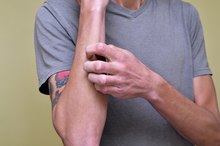How to Remove Scars After Waxing
Waxing scars can be hard to get rid of, particularly those in a visible area, such as on your lip or chin 1. Waxing is popular because it is relatively inexpensive and results last for a few weeks. However, it also can create burning and scarring if performed improperly. Fortunately, if you have scars formed as a result of waxing, there are plenty of treatments at your disposal 1.
Purchase an OTC lotion or cream that contains alpha hydroxy acids. Spread this liberally over the scarred area to help reduce its appearance. Alpha hydroxy acids exfoliate the skin, sloughing away dead tissues and stimulating the growth of new skin, which may reduce the appearance of superficial scars more quickly 1.
How to Get Rid of Stitch Scars on the Face
Learn More
Apply silicone gel to your wax scar. Some researchers believe it works by creating static electricity, helping to smooth out the scar. It may also help increase blood flow to the affected area so the scar's appearance is minimized.
Use dermabrasion to remove outer skin layers. A dermatologist will use an abrasive, rotary tool to blast crystalline particles onto the skin, removing the dermis and epidermis skin layers. Dermabrasion treatments are an aggressive method to get rid of scars and may require a few weeks to a couple of months recovery time 1.
How to Remove an Indented Scar
Learn More
Try a chemical peel for superficial waxing scars 1. Some lighter peels use glycolic, trichloroacetic, and alpha hydroxy acids to chemically remove damaged skin cells. They promote cell turnover and the promote fading of scars 1. Your dermatologist will choose the correct chemicals in correspondence to how severe your scars may be 1.
Warnings
Always consult your physician before attempting any scar removal treatment on your own. Depending on the severity of the scar, you could end up making it worse.
Related Articles
References
- DocShop.com: Scars
- Fabbrocini, G, Annunziata, MC, D'Arco, V, et al. Acne scars: pathogenesis, classification and treatment. Dermatol Res Pract. 2010;2010:893080. doi:10.1155/2010/893080
- Kravvas G, Al-niaimi F. A systematic review of treatments for acne scarring. Part 1: Non-energy-based techniques. Scars Burn Heal. 2017;3:2059513117695312. doi:10.1177/2059513117695312
- Gozali MV, Zhou B. Effective treatments of atrophic acne scars. J Clin Aesthet Dermatol. 2015;8(5):33-40.
- Wollina U, Goldman A. Fillers for the improvement in acne scars. Clin Cosmet Investig Dermatol. 2015;8:493-9. doi:10.2147/CCID.S86478
- Kravvas G, Al-niaimi F. A systematic review of treatments for acne scarring. Part 2: Energy-based techniques. Scars Burn Heal. 2018;4:2059513118793420. doi:10.1177/2059513118793420
- Ogawa R. Keloid and hypertrophic scars are the result of chronic inflammation in the reticular dermis. Int J Mol Sci. 2017;18(3). doi:10.3390/ijms18030606
- Rabello FB, Souza CD, Farina júnior JA. Update on hypertrophic scar treatment. Clinics (Sao Paulo). 2014;69(8):565-73. doi:10.6061/clinics/2014(08)11
- França K, Keri J. Psychosocial impact of acne and postinflammatory hyperpigmentation. An Bras Dermatol. 2017;92(4):505-509. doi:10.1590/abd1806-4841.20175645
- Tosti, A, De Padova, MP, Beer, KR, eds. Acne Scars: Classification and Treatment. London: Informa UK Ltd.; 2010.
Writer Bio
David Friedman began writing professionally in 2004. His work appears in the "Daily Illini" and various websites. Friedman is a certified personal trainer through the American College of Sports Medicine and has Bachelor of Science in exercise science from University of Illinois at Urbana-Champaign.









